The title of this exhibit at Road to California 2017 says it all, "Put a Bird on It." It's quite interesting how the idea was carried out in each of these quilts.
 |
The title of this exhibit at Road to California 2017 says it all, "Put a Bird on It." It's quite interesting how the idea was carried out in each of these quilts.
 |
If you make two of these practical pincushions, one for each wrist, you can become Wonder Woman (they just might not be able to repel bullets). Daniela Gutierrez-Diaz at WeAllSew.com has a pincushion wristband tutorial so you can do just that.

Is it just me, or have some of you found that the active life and quilting do not co-exist peacefully?
I want to be an art quilter. That takes time. It requires long periods of sitting, thinking, dreaming, sketching, and finally sewing. Moving from the sewing machine to the ironing board is not mentioned on the American Heart Association's list of recommended exercise. And after a while, sitting for long periods of time is actually not very comfortable.
On the other hand, I want to be healthy. Regular exercise is a very important part of good health. And exercise takes time too! Somehow I've got to figure out how to intermingle these two disparate parts of my life into one healthy balanced life.
Here are a few things that have worked for me in the past few months.
Functional exercise! Gardening and quilting seem to go together quite often. If you have a lot of work to do in the garden, not only will it nourish your soul and your creativity, quite often it will give you a very good workout for the day.
When I am working consistently on a single quilt project, many times I will come to a point where I no longer even like it! Or, I will just be stumped as to which way to go next. That's the time to grab the dog and head out for a short walk. Oftentimes, I will walk back into the house and see my work with fresh eyes, and know exactly what the next step is.
If I've had a good day of quilting, sometimes I am ready to quit for the day by 2pm. That's when I head down to the gym for some work on the weight machines, the bike, or a swim in the pool.
Another thing I have been doing (to increase my aerobic workout and also to decrease my total exercise time,) is HIIT (High Intensity Interval Training.) Basically, I walk as fast as I can for 100 paces, and then walk normally for 20 steps. I repeat this 8 to 10 times, and end my walk with a nice stroll. There is a lot of evidence that this type of exercise can raise your metabolic rate and give you a more effective workout in a shorter period of time (more time to quilt!!)
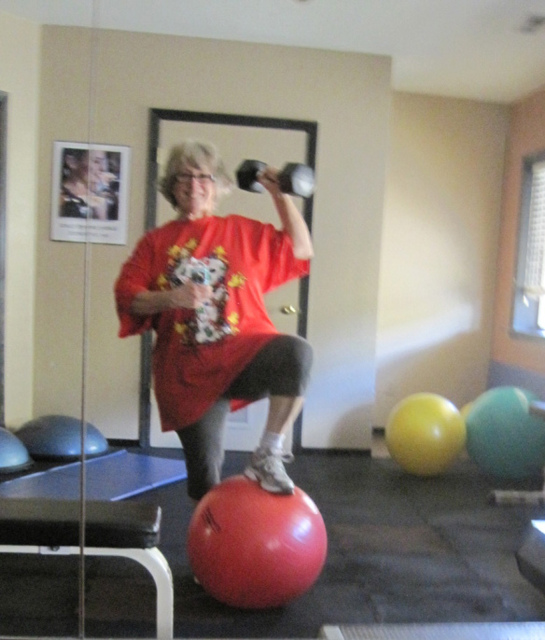
What if you are injured? Or old? Or out of shape? Check, check, and check. Been there, done that. I wrote about it here--You Can Always Do Something!
Exercise is going to take time. There's no two ways about it. But changing my intention and attitude about it will go far in helping me to incorporate it into my life without resenting the time it takes. And eventually, I came to realize that I did love exercise.
I don't know about you, but if there is one fabric manufacturer that always hits it out of the park with prints that are like art, it is Alexander Henry. I saw this bolt at the Stitchin' Post and it was a WOW moment. Sometimes you just stand there with the 'ol brain in overdrive trying to decide if you need a dress instead of a quilt made out of the fabric. Has anyone else succumbed to this bolt of fabric??? And, what did you create?
Due to inclement weather...you know...those big white things that fall out of the sky and bury half a car...I was not able to attend the First Friday Quilt Gallery Show at QuiltWorks in Bend. But Marilyn, the owner, keeps the show up for a full month and so when the sun came out and the snow receded I headed over and took in the show. I wanted to share the Featured Quilter's exhibit. This month's featured quilter is a long standing quilter, teacher, and artist in Central Oregon, Jackie Erickson. She has taught at the Quilter's Affair in Sisters for several years. About three years ago I took her Wonky Log Cabin class and it was nothing but a great time! She has a way when it comes to deciding how to put her blocks together to create a one of kind design. Enjoy the show, and if you make it to the Quilter's Affair in Sisters, consider taking a class with Jackie!
Click here to visit Anna's blog.
Click here to visit Anna's YouTube channel.
 |
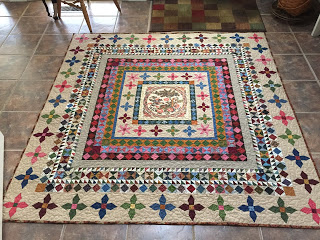
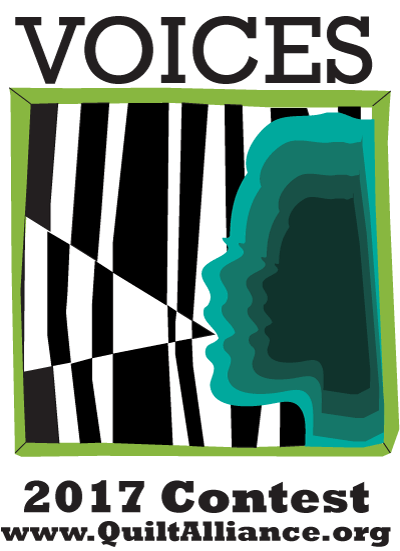
As part of their mission, the Quilt Alliance records the stories of quilts and quiltmakers through their oral history projects. They value the human voice as well as your voice expressed in cloth and thread. They encourage everyone who makes quilts to enter their annual contest regardless of their style (traditional, modern, art) or technique (longarm, hand quilting, applique, pieced…) –all are welcomed and valued!
They invite entrants to share their opinions, polemics, memories, language, conversation and truths in the form of a quilt. Help them document the state of quilting in 2017—let your voice be heard.
Click here for more on entry rules, deadlines, and prize information.
There is no fee to enter. But you must be a member of the Quilt Alliance to participate. Join or renew online here.
All entries become a donation to the Quilt Alliance, a 501(c)(3) nonprofit, and after exhibition, will be auctioned to benefit the mission of the organization. All entries will be documented and shared on the Quilt Alliance website.
The last day to register and postmark your quilt is June 2, 2017 until midnight CST. (May 1, 2017 is the deadline for submission for all artists ordering photography of their quilt).
Marianne Fons and Quilts of Valor need your help.
For the first time a GoFundMe campaign has been launched.
From the site:
The Quilts of Valor® Foundation’s mission is to cover service members and veterans touched by war with comforting and healing Quilts of Valor. In 2016, over 19,000 Quilts of Valor were awarded stateside, from sea to shining sea, as well as in Iraq, Afghanistan and at Landstuhl Regional Medical Center in Landstuhl, Germany. A Quilt of Valor is made totally by volunteers who give of their time and resources to make the highest quality quilt they can. The estimated cost is $250 per quilt, which includes fabric for the top, batting (filler), backing fabric, and shipping. We ask for your financial help to enable more quilts to be made and awarded. All funds collected will be provided to individual groups of quilters around the country to further the mission of Quilts of Valor Foundation. Please donate today and help us honor a veteran with a comforting and healing Quilt of Valor. As of January 15, 2017, QOVF has recorded the awarding of over 151,000 Quilts of Valor.
To learn more about the program, here is a clip from the 73-minute documentatry, Quilts of Valor, featruing Eleanor Burns, Alex, and Mark Lipinkski. The program, hosted by Marianne Fons, was originally aired on PBS a few years back.
To learn more about the Quilts of Valor program, click here.
Creating maximum effect using line does not have to be complicated. This week, Deborah Boschert shares how she uses the elements of line to captivate by examining two of her quilts in depth. Through the use of subtle, but effective lines, she shows how she holds the viewers attention while being guided along the journey around the quilt.
When designing a quilt, all the elements are carefully chosen to work together to create the over all visual impact. Line is one of the elements that can be a part of the design. A line can define a shape, suggest movement, add texture or fill a space. It can be thick or thin, straight or curvy, controlled or random. It can be created with fabric, stitching, or surface design.
It’s helpful to embrace these different ways to describe and understand line. Then when you are designing a quilt, you can think clearly about the different ways line can be used to maximum effect.
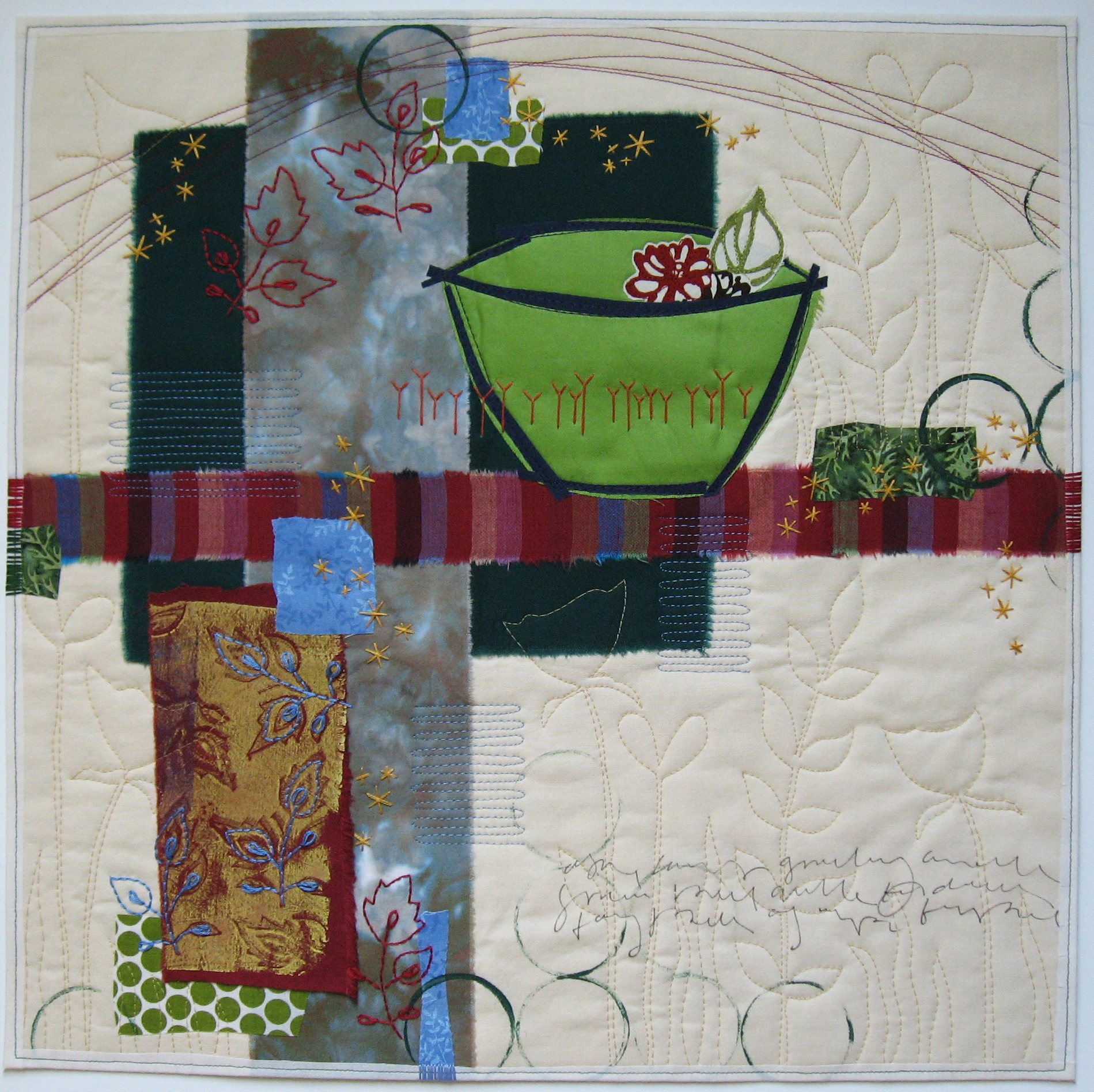
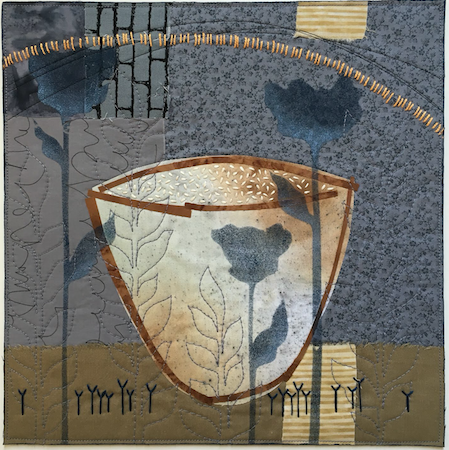
Green Bowl Gathering Small Multitudes
In quilting, a line can be created in so many ways! Let’s look at some examples. In Small Multitudes and Green Bowl Gathering, we can deconstruct the art quilts and pick out different ways I’ve used line.
In both, I’ve outlined the bowls using strips of fabric fused over the bowl shapes. I chose to make the lines relatively chunky and irregular. These lines remind me of thick magic marker sketches. Imagine how different it would look if I’d placed the outline precisely along the edge of the bowl shapes with no breaks or overlapping.
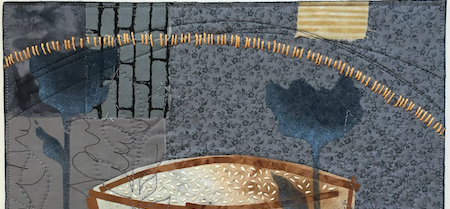
Detail Small Multitudes by Deborah Boschert
Both art quilts also have arched lines at the top. In Small Multitudes, the line is hand-stitched in yellow. In fact, each stitch is a tiny line and they work together to visually create the arched line. Additional arches are machine stitched in black thread. Those are much thinner, more subtle lines. In Green Bowl Gathering, I machine stitched similar lines in red. Making several lines of stitching over lapping each other and in slightly different shapes creates the overall effect of an arched line, but the multiple lines give it variety, movement and interest.

Maybe the most dramatic line in Green Bowl Gathering is the strong, horizontal strip that goes all the way from the left to the right. Everything else is built up around that line. (This horizontal line is made up of the shorter vertical lines of the striped fabric. Think about how different it would look if I’d used that same fabric with the stripes running horizontally.
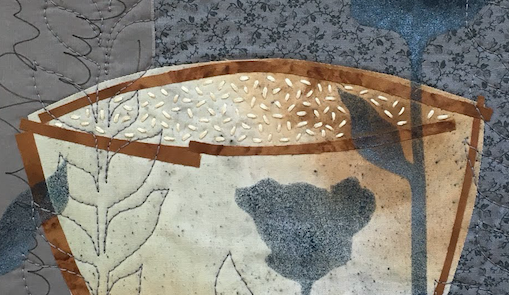
There are several other small details incorporating lines in these two quilts. The tiny seed stitches that appear to fill the bowl are lines. The free motion quilted leafy shapes in the background are also lines.
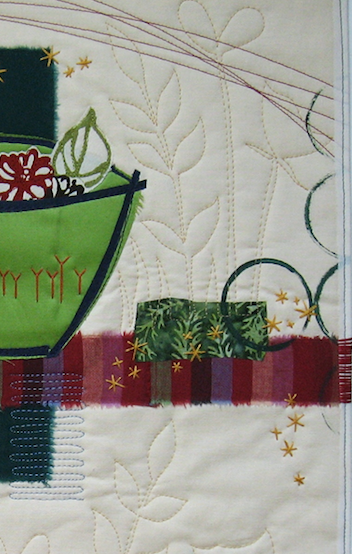
The green circles in Green Bowl Gathering are printed with paint — some thick and blobbly, others thin and faint. When you consider the possibilities of each individual line, you can really take control of the design of a quilt.
As you’re designing your own original art quilt, zero in on the idea of how you can use lines to maximum effect. Will the lines be made from fabric? Or stitched with thread? Or created with paint, ink or dye? Think about how the design would change if a line were thinner or thicker. Are you most comfortable making controlled straight lines? What would happen if you tried something loose and gestural?
There’s no right or wrong way to think about all these details. But, giving them some close consideration may open up new possibilities in the creative process.
To learn more about Deborah Boschert, visit her website, follow her blog, or sign up for her enewsletter.
Looking for ways to use line when it comes to a traditional design? Let's look at Janet Stone's Red Letter Daze. Janet (Show 1401) loves to take the viewer on a journey around, across and into her quilts. A huge fan of over the top details, see if you can spot how many ways Janet has included line in her 2012 NQA Masterpiece Award Winner.
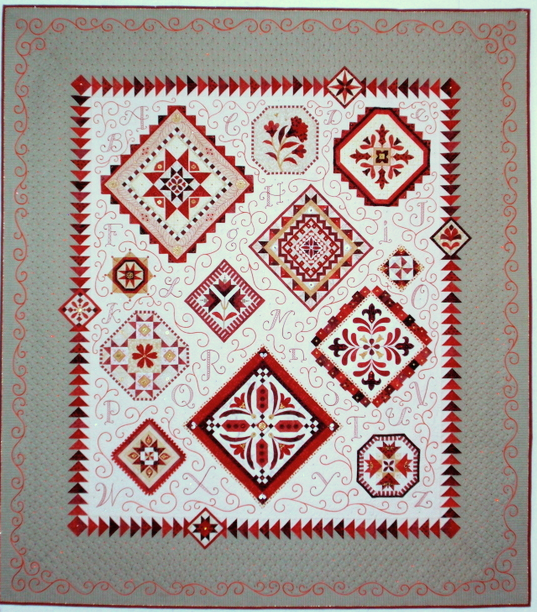
Here are a few examples of Janet's masterful use of line:
Notice (left image) how the curved red lines flow along the edge of the outside border, while Flying Geese (and an occasional small block) take the eye journey around the central creamy field.
Notice (right image ) how the letters of the alphabet and the repeated curved lines flow around each of various block designs. The gentle curves of the letters and undulating lines help to soften the more angular Flying Geese and blocks in the center field.
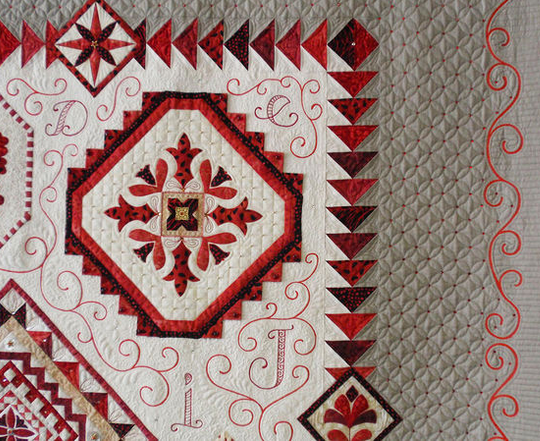
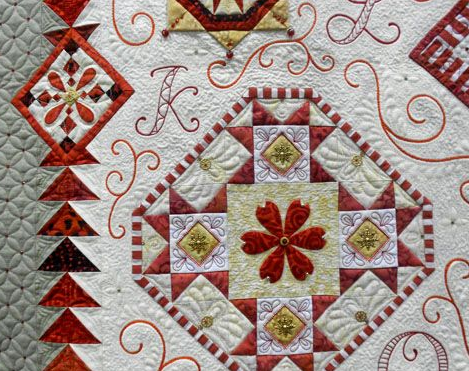
See the entire quilt in our zoom format here.
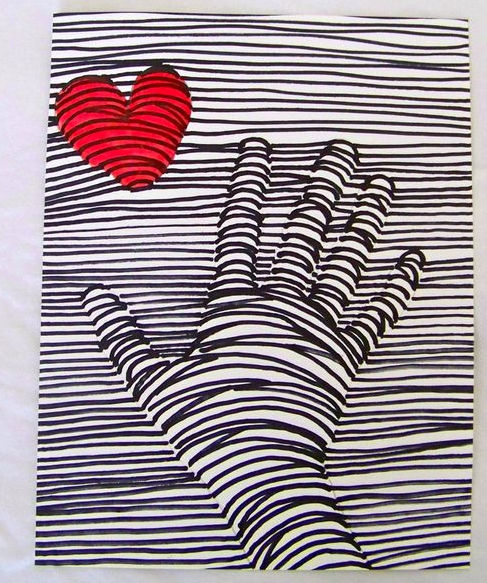
Adaptation of hand drawing exercise from Art is Every Day by Eileen S. Prince
Place your nondominant hand and bare forearm in a pleasing manner on a piece of white paper. Splay your fingers slightly, but keep your thumb as vertical as possilble. Using a pencil, lightly trace around your arm and hand. Place or draw another object, such as a heart, near your hand tracing. Trace this item lightly as well.
Using a dark marker, begin drawing a straight line (from the left side of the page) parallel to the lower edge. When you come to your pencil line, curve the line up slightly. Curve back down to the pencil line on the other side, and continue across the page. Repeat with each new line being about 1/4" above the previous. Try to keep your lines as straight and horizontal as possible. Repeat the process for the heart.
On a piece of plain fabric trace your hand and the heart in the same manner as Option 1. Make a quilt sandwich and machine quilt with a thread of your choosing using the same method of curving slightly when you reach a traced line.
Click here for more topics related to the Design to Quilt program.
Look what Diane Nelson wore to the LEGO Batman Movie premiere. Would you wear this for a night on the town? Could you adapt the "brick" idea into a quilt block idea?
The jacket was designed by renowned LEGO artist Nathan Sawaya and was inspired by the “Necessary Evil” sculpture from The Art of the Brick: DC Comics exhibit. It took Nathan more than 10,000 pieces, most of which are 2×2 plates, and over 100 hours to create.
Click here to see more photos.
(Photo: www.TheBrickFan.com)
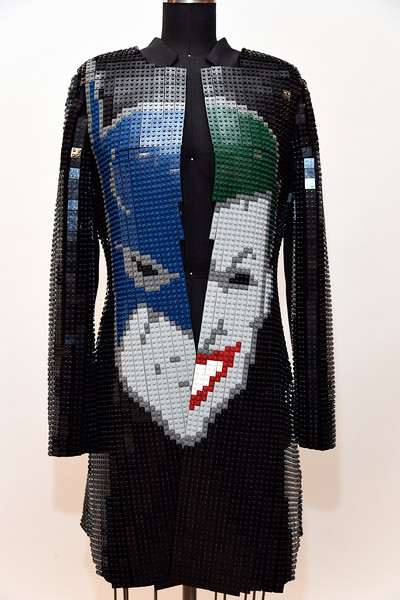
by Lucas Davis
Star Members can watch more of Amy in Show 2004: Into the Woods We Go - Embroidery with Whimsy in Stitches.